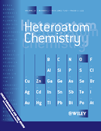N-phosphinyl ureas: Synthesis, characterization, X-ray structure, and in vitro evaluation of antitumor activity
Abstract
A new series of N-phosphinylureas 5b, 6a–7c was synthesized and characterized by 1H, 13C, 31P NMR, IR, and elemental analysis. The three-dimensional structure of 5b has been determined by X-ray crystallography. The crystal structure revealed the existence of four independent molecules. All structures form two chains with different arrangements and connect to each other via hydrogen bonds to produce two-dimensional polymeric chains. The cytotoxicity of cyclophosphamide (a standard antitumor compound) and its nine analogues with formula R1C6H4 NHC(O)NHP(O)XCH2C(R2)2 CH2Y(X = Y = NH, R2 = CH3, R1 = H (5a), CH3 (5b), NO2 (5c), X = O, Y = NH, R2 = H, R1 = H (6a, CH3 (6b), NO2 (6c), and X = Y = O, R2 = CH3, R1 = H (7a), CH3 (7b), NO2 (7c)) as well as phenyl urea were evaluated in vitro against three human tumor cell lines K562, MDA-MB-231, and HepG2. The results showed that most of the compounds have significant activity against the selected cell lines. Also, HepG2 cells were more sensitive to all the tested compounds than other cell lines. © 2011 Wiley Periodicals, Inc. Heteroatom Chem 23:74–83, 2012; View this article online at wileyonlinelibrary.com. DOI 10.1002/hc.20754




